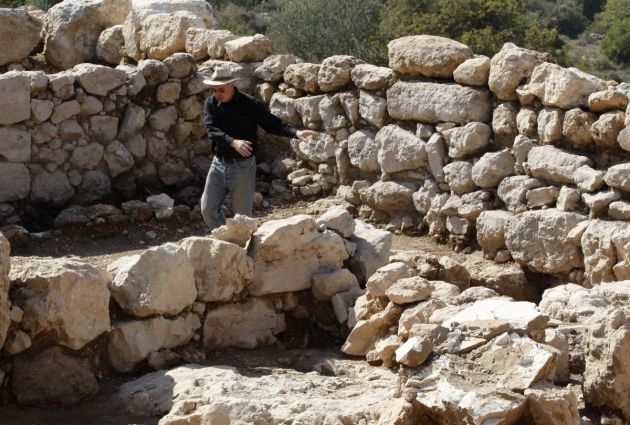Israel archaeology dig provides evidence of King David's reign

Israeli archeologists claim they have found a palace belonging to King David in a Judean historical cite they have been excavating for the last several years.
The discovery in the ancient city of Khirbet Qeiyafa by researchers Yossi Garfinkel and Saar Ganor lends credence to the existence of a royal kingdom under David in Judea as indicated in the Bible.
Digging has been going on in Khirbet Qeiyafa for the last seven years, according to a report in the Jerusalem Post newspaper on July 18.
The excavation is a joint effort between Hebrew University and the Israel Antiquities Authority.
As the archeologists dug, they discovered evidence that the site was a fortress in the 10th century BCE, when David is said to have lived.
"The ruins are the best example to date of the uncovered fortress city of King David," said Garfinkel and Ganor, who led the excavations. "This is indisputable proof of the existence of a central authority in Judah during the time of King David."
Garfinkel claimed in 2012 that the discovery of the fortress itself provided proof that David was more than a myth or minor figure in history, the UK's Daily Mail newspaper reported on July 20.
"This is the first time that archeologists uncovered a fortified city in Judah from the time of King David," said Garfinkel, a professor at Hebrew University, at the time.
"Thus, various suggestions that completely deny the biblical tradition regarding King David and argue that he was just a mythological figure or just a leader of a small tribe, are now shown to be wrong."
Scott Ashley, managing editor of the Good News magazine, a publication of the United Church of God, wrote of the findings last year, also.
"The view many Bible critics long held was that Kings Saul, David and Solomon were mythical figures invented by Israelites to enhance their history," he said.
"When the 1993 discovery of the Tel Dan stele with its inscription referring to the 'house (dynasty) of David' provided David's existence, the argument then shifted to dismissing the biblical record of him as a king over Judah and Israel, with critics arguing that he was nothing more than a tribal leader of no real significance, and that the kingdoms of Judah and Israel didn't exist until centuries later.
"This is where the findings at Khirbet Qeiyafa prove significant," said Ashley.
Garfinkel and Ganor believe that the Khirbet Qeiyafa is the location of the ancient city of Sha'arayim, mentioned in several passages of the Bible's Old Testament.
The place name means two gates, and this is the only archeological site in the ancient kingdoms of Judah and Israel that contains that feature, the researchers wrote in the Journal of Hebrew Scriptures in 2008.
Ganor aroused the interest of archeologists in 2005 when he discovered impressive Iron Age structures under later remains. The researchers said that although European explorers visited Khirbet Qeiyafa in the 19th century, the city was neglected after that.
It is located on a ridge in the Elah Valley 18 miles (29 kilometers) southwest of Jerusalem. The area is located on the border of the ancient nations of ancient Israel and Philistia.
The area is where David and Goliath had their epic confrontation, as recorded in the Bible.
Garfinkel and Ganor provided details of the two large buildings, including the one they said was David's palace, according to Fox News.
"The southern part of a large palace that extended across an area of about 1,000 square meters [10,800 square feet] was revealed at the top of the city," Garfinkel and Ganor detailed.
"The wall enclosing the palace is about 30 meters [100 feet] long and an impressive entrance is fixed it through which one descended to the southern gate of the city, opposite the Valley of Elah.
"Around the palace's perimeter were rooms in which various installations were found - evidence of a metal industry, special pottery vessels and fragments of alabaster vessels that were imported from Egypt," they said.
The other building they said was a royal storage facility.
A U.S. professor of archeology and biblical backgrounds said he had doubts that the researchers found David's palace, although he agreed that the findings were important.
Baptist Press reported that Steven Ortiz of Southwestern Baptist Theological Seminary attended a celebration ceremony at the unveiling of the alleged palace site.
"It is an important site for the history of the Israelite monarchy," Ortiz told Baptist Press.
"I think Dr. Garfinkel might be overstating the large building. It is indeed a very large building sitting on the acropolis, perfect for a public building."
"The site dates to the time of the Davidic monarchy. It is a bit of a stretch to say that it is David's palace," Ortiz said.
"If David built a palace it would be in Jerusalem, as the biblical text implies, not in an outlying fortress city. It is best to state that Khirbet Qeiyafa was perhaps a city under the hegemony of the developing Davidic monarchy."
This acknowledgement by Ortiz is itself an important statement because some think the city was actually ruled by the Philistines.